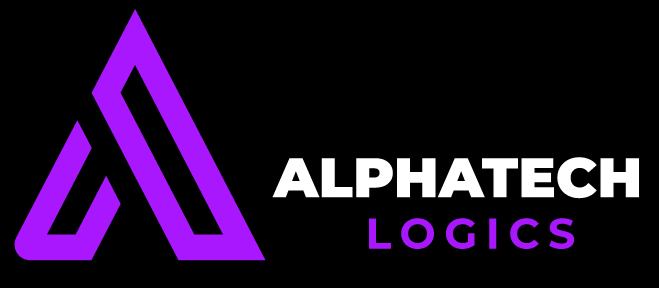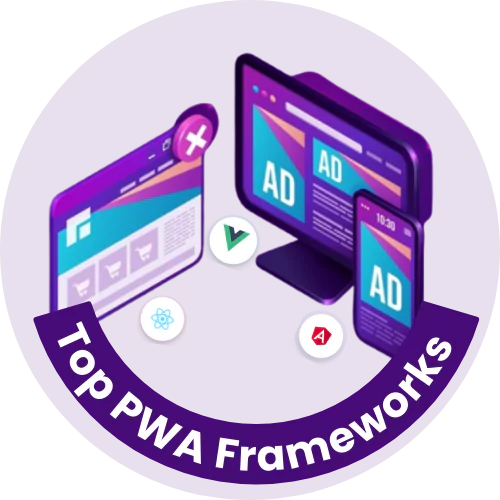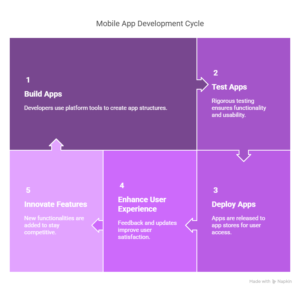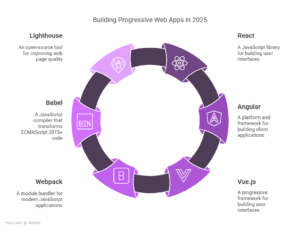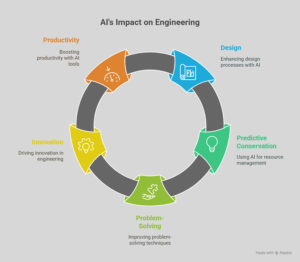Top Frameworks and Tools to Build Progressive Web Apps in 2025
Progressive Web Apps (PWAs) continue to bridge the gap between web and mobile apps by offering a smooth, app-like experience directly from your browser. With offline support, push notifications, and lightning-fast speed, PWAs have become a favorite for businesses and developers alike.
In 2025, the PWA development scene will be more powerful than ever. Let’s explore the top frameworks and tools you can use to build high-performing PWAs this year.
1. React + Vite / Next.js
React remains a top choice for building PWAs, and in 2025, it’s even more powerful when combined with modern tools like Vite or Next.js.
- React + Vite offers super-fast build times and a clean developer experience.
- Next.js adds SSR (Server Side Rendering), API routes, and built-in PWA support.
Why choose it?
✔️ Large community
✔️ Tons of ready-made components
✔️ Excellent performance with pre-rendering and lazy loading
2. Angular
Google’s own Angular framework has solid PWA support built-in. It comes with a CLI tool that can add service workers and other essentials with just one command.
Why choose it?
✔️ Built-in support for PWAs
✔️ Great for large-scale enterprise apps
✔️ Strong TypeScript integration
3. Vue.js + Nuxt 3
Vue continues to win hearts with its simplicity, and in 2025, Nuxt 3 brings even more power to PWA development.
- Nuxt 3 offers automatic PWA module integration.
- Includes SSR, static site generation, and serverless functions.
Why choose it?
✔️ Easy to learn and use
✔️ Powerful out of the box
✔️ Great performance and flexibility
4. Svelte + SvelteKit
SvelteKit has been a game-changer in the world of modern web development. It compiles components into highly optimized JavaScript with minimal runtime.
Why choose it?
✔️ Lightning-fast apps
✔️ Clean, readable code
✔️ Built-in support for PWA features
5. Ionic + Capacitor
If you’re looking to build PWAs and mobile apps at the same time, Ionic paired with Capacitor is a fantastic choice.
- Ionic offers beautiful UI components.
- Capacitor helps you access native mobile APIs and deploy to app stores.
Why choose it?
✔️ Cross-platform (Web + Mobile)
✔️ Easy to integrate native features
✔️ Works with Angular, React, or Vue
6. PWA Builder (by Microsoft)
This is a super handy tool if you want to turn your website into a PWA quickly. Just plug in your site URL, and it helps you generate everything you need: service workers, manifests, and even store-ready packages.
Why choose it?
✔️ No coding needed
✔️ Fastest way to PWA
✔️ Great for converting existing sites
7. Workbox (by Google)
Workbox is a powerful library that helps you handle caching, offline functionality, and service worker logic with ease.
Why choose it?
✔️ Handles the tricky parts of service workers
✔️ Helps optimize performance and reliability
✔️ Fully customizable
Final Thoughts
PWAs in 2025 are more capable than ever. Whether you’re building from scratch or converting an existing site, there’s a framework or tool that can help you deliver a fast, engaging experience.
- For reactive UI lovers – React, Vue, and Svelte are fantastic.
- For enterprise-grade apps – Angular still shines.
- For mobile-first development – Ionic + Capacitor is a smart combo.
- For easy conversion – PWA Builder is your friend.
Choose what fits your workflow and app goals best, and start building the future of the web today.

